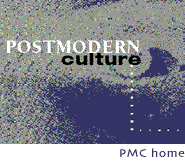
The Xenotext Experiment: An Interview with Christian Bök
Stephen VoyceYork University
svoyce@yorku.ca
© 2007 Stephen Voyce.
All rights reserved.
- Christian Bök was born on 10 August 1966 in Toronto, Canada. He began writing seriously in his early twenties, while earning his B.A. and M.A. degrees at Carleton University in Ottawa. He returned to Toronto in the early 1990s to study for a Ph.D. in English literature at York University, where he encountered a burgeoning literary community that included Steve McCaffery, Christopher Dewdney, and his good friend Darren Wershler-Henry. Bök's published work includes two collections of poetry: Crystallography (Coach House, 1994) and the best-selling Eunoia (Coach House, 2001), the latter of which earned the Griffin Prize for Poetry in 2002. He has also authored a critical study entitled 'Pataphysics: The Poetics of an Imaginary Science (Northwestern UP, 2002). Well regarded for his reading of Kurt Schwitters's Ursonata, Bök has performed his sound poetry all over the world. His conceptual artworks include Bibliomechanics, a set of poems constructed out of Rubik's Cubes, and Ten Maps of Sardonic Wit, a book created entirely from Lego bricks. His artistic endeavors have showcased at the Marianne Boesky Gallery in New York and with the traveling text art exhibition, Metalogos. Bök has also produced two artificial languages for science-fiction television shows: Gene Roddenberry's Earth: Final Conflict and Peter Benchley's Amazon. He currently resides in Calgary, Alberta, where he teaches in the Department of English at the University of Calgary.
- Bök's second collection of poems, Eunoia, has garnered considerable attention for the author. The purpose of this interview is to address the wider scope of his artistic practice and to discuss his current project, The Xenotext Experiment, which explores the intersection between poetry and biotechnology. Between 11 May and 15 July 2006, Dr. Bök and I corresponded via email.
- Stephen Voyce: When did you first begin to write poetry? How would you describe those initial efforts at writing verse?
- Christian Bök: I began writing poetry in my late adolescence, producing work inspired mostly by the likes of Michael Ondaatje, Leonard Cohen, and Gwendolyn MacEwan. I published some of this juvenilia, but I became convinced late in my undergraduate career that, if I continued writing emotive, lyrical anecdotes, then I was unlikely to make any important, epistemic contributions to the history of poetry. I decided to become more experimental in my practice only after I encountered the work of Steve McCaffery during my graduate studies. I was surprised to discover that, despite my literary training, none of my professors had ever deigned to expose me to the "secret history" of the avant-garde (what with its wonderful zoo of conceptual novelties and linguistic anomalies). I realized then that, by trying to write emotional anecdotes, I was striving to become the kind of poet that I "should be" rather than the kind of poet that I "could be." I decided then that I would dedicate my complete, literary practice to nothing but a whole array of formalistic innovations.
- SV: This assumption about what a poem "should be"--can you elaborate on this statement? Why has the emotive lyric become almost synonymous with poetry as such?
- CB: Unlike other artists in other domains where avant-garde practice is normative, poets have little incentive to range very distantly outside the catechism of their own training--and because they know very little of epistemological noteworthiness (since they do not often specialize in other more challenging disciplines beyond the field of the humanities), they tend to write about what they do know: themselves, their own subjectivity. The idea that a writer might conduct an analytical experiment with literature in order to make unprecedented discoveries about the nature of language itself seems largely foreign to most poets.
- SV: That said, has the concept of formal innovation changed since high modernism?
- CB: Postmodern life has utterly recoded the avant-garde demand for radical newness. Innovation in art no longer differs from the kind of manufactured obsolescence that has come to justify advertisements for "improved" products; nevertheless, we have to find a new way to contribute by generating a "surprise" (a term that almost conforms to the cybernetic definition of "information"). The future of poetry may no longer reside in the standard lyricism of emotional anecdotes, but in other exploratory procedures, some of which may seem entirely unpoetic, because they work, not by expressing subjective thoughts, but by exploiting unthinking machines, by colonizing unfamiliar lexicons, or by simulating unliterary art forms.
- SV: Many readers of contemporary poetry are familiar with Eunoia, given its critical and commercial success. Your first collection of poems, Crystallography, is a quite different book in many ways. Comprised of odes, sound poems, anagrams, quasi-scientific diagrams and indexes, the book demonstrates your interest in combining poetic and non-poetic art forms. You describe it as a "'pataphysical encyclopedia." Could you elaborate?
- CB: Crystallography (my first book of poetry) attempts to put into practice some of my theoretical suppositions about 'pataphysics. Inspired by the etymology of the word "crystallography," such a work represents an act of "lucid writing," which uses the lexicon of geological science to misread the poetics of rhetorical figures. Such lucid writing does not concern itself with the transparent transmission of a message (so that, ironically, much of the poetry might seem "opaque"); instead, lucid writing concerns itself with the reflexive operation of its own process (in a manner reminiscent of lucid dreaming). Such an act of sciomancy borrows much of its crystalline sensibility from the work of Jean Baudrillard, who argues that, for 'pataphysics, every phenomenon exceeds its own containment within the paradigm of a theoretical explanation. The crystal represents hyperbolic objecthood--a thing impervious to analysis: captivating because it is indifferent; frustrating because it is meaningless. The crystal invites us to enter a poetic prison of surfaces without depth, a prismatic labyrinth of mirrors that revolve into themselves--hence, we lose ourselves when we gaze into this crystal because it promises us answers to all the questions that we exact from it, but instead it ensnares us viewers with even more questions to be asked of it.
- SV: Two responses: first, Alfred Jarry's concept of 'pataphysics may require some explanation for readers unfamiliar with this notion. Second, since Crystallography attempts to negotiate poetic form through the conceit of geology, one might call it a "nature poem." Is there an attempt to radically overhaul our notion of this genre?
- CB: 'Pataphysics is the "science of exceptions" imagined by Alfred Jarry. 'Pataphysics occupies a cognitive interzone between ratiocination and hallucination, appearing on the eve of postmodernity at the very moment when science has begun to question the paradigm of its own rational validity. 'Pataphysics proposes a set of "imaginary solutions" for proposed problems, proposing absurd axioms, for example, then arguing with rigor and logic from these fundamentals. In contrast with metaphysics, which has striven to apprehend the essence of reality itself and is thus a kind of philosophy of the "as is," 'pataphysics is more like a philosophy of the "as if," giving science itself permission to dream--to fantasize, if you like. I argue that, if poetry cannot oppose science by becoming its antonymic extreme, perhaps poetry can oppose science by becoming its hyperbolic extreme, using reason against itself in order to subvert not only pedantic theories of absolute verity, but also romantic theories of artistic genius. I think that my book on crystals does not portray the nature of crystals, through either description or explanation, so much as my book tries to emulate the formal system of crystals, mimicking the processes inherent in their symmetries and their branchings.
- SV: Speaking of the book, you place considerable importance on its material production. Typesetting a text replete with diagrams, transparent paper, and letter-fractals requires a great deal of precision. Did the composition of this text require you to learn desktop publishing software?
- CB: Crystallography does require intensive labor to print, and I have in fact stopped production of it upon discovering the mis-registration of a single title-line, but in a book about the "aesthetics of perfection," I think that this kind of attention to detail is appropriate to the mandate of the work.
- Gilles Deleuze and Félix Guattari have argued that each book must lay itself out upon a super plane, a vast page, doing so both extensively and expansively, without the internal closures of a codex. The idea of the book, for me, has becoming something more than a temporal sequence of words and pages. The book need no longer wear the form of codices, scrolls, tablets, etc.--instead, the book of the future might in fact become indistinguishable from buildings, machinery, or even organisms. I think that the book is itself a weird object that might not exist, except at the moment of its reading--for until then the book always pretends to be something else (a stack of paper, a piece of décor, etc.). I want each of my own books to burgeon into the world, like a horrible parasite, exfoliating beyond itself, evolving along its own trajectory, against the grain of truth and being.
- SV: How then does Crystallography specifically operate beyond the "closures" of a conventional book? For me, it eschews the notion of a poetic "sequence" in favor of something closer to a constellation, a book spatially organized. You write, if a crystal is a mineral "jigsaw puzzle" that "assembles itself out of its own constituent / disarray," then a "word is a bit of crystal in formation" (12). Can this be applied to the book, too?
- CB: Crystallography is definitely, definitely an extension of what Eugen Gomringer in the world of visual poetry might call a "constellation"--words arranged artfully into a rigorous structure across the field of the page. My book consists of conceptual fragments, all configured into a crystalline latticework of correlated, figurative devices.
- SV: Finally, in regards to your first book, I'd like to ask a specific question about one of the poems, "Diamonds." It is one of your few attempts at a lyric poem. Yet when you read it in Toronto at the Art Bar Reading Series, many in the audience found your "machine-like" performance somewhat disturbing, as if you had eradicated any sentimentality from the text. Is there a conscious attempt on your part to perform a lyric poem in this way?
- CB: "Diamonds" consists of very tiny "opuscules" of words, all arranged according to a lettristic constraint, in which each line of each fragment contains the same number of characters (including spaces). I have written this poem in order to demonstrate that a "heartfelt" sentiment can arise spontaneously from a rule applied with a rigorous, technical detachment. I have expressed no lyrical content about my own biography at all within the poem, and my "mechanical" performance of the poem probably arises, I think, from the mechanical preciseness of its architecture.
- SV: I would like for us to turn to your second collection of poems,
Eunoia. Can you describe this text and what is now commonly referred to as
"constraint writing"? (Readers can find a flash version of the poem's "Chapter E" by visiting
Coach House Books
and an mp3 file of Bök reading the text in its entirety by visiting
UbuWeb.[1])
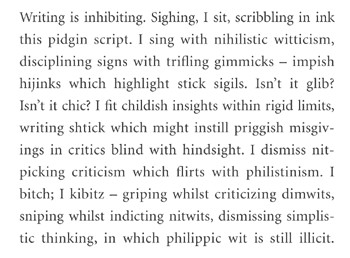
Figure 5: "Chapter I"
Christian Bök, Eunoia 50
Courtesy of Coach House Books - CB: Eunoia (my second book of poetry) strives to extend the formal rigor of "crystallinity" into the realm of linguistic constraint--in this case, a univocal lipogram, in which each chapter restricts itself to the use of a single vowel (the letter A, appearing only in the first section; the letter E, appearing only in the second section, etc.). Coined by Aristotle to describe the mentality required to make a friend, the Greek word "eunoia" is the shortest word in English to contain all five vowels, and the word quite literally means "beautiful thinking." Eunoia has received much fanfare, appearing for five weeks on the bestseller list of The Globe and Mail after winning the Griffin Poetry Prize, now worth $50,000. Eunoia responds directly to the legacy of Oulipo (l'Ouvroir de Littérature Potentielle)--an avant-garde coterie renowned for its experimentation with exaggerated, formalistic rules. Oulipo rejects the metaphysical surrealism of inspired insights in order to embrace what the poet Jacques Roubaud calls a "mathematical surrealism"--a unique phylum of 'pataphysics, one that formulates methodical, if not scientific, procedures for the production of literature, thereby conceiving of difficult, potential problems that require a rigorous, imaginary solution. Oulipo imposes arbitrary, but axiomatic, dicta upon the writing process in order to evoke an unpredicted possibility from these experimental restrictions. Such laborious exercises reveal that, despite any instinct to the contrary, even the most delimited behavior can nevertheless generate both artful liberty and poetic license.
- SV: The last time I checked, Eunoia was up to 20 print runs, and "Chapter I" was recently featured in Harper's Magazine. Does it surprise you that a book of poems--particularly one dubbed "experimental"--has had so much popular success?
- CB: I am surprised that my own work of experimental poetry has enjoyed popular success, selling more than 20,000 copies at last count, but this number still pales in comparison to the success of other cultural artifacts in other art forms--so I still feel that I have a very long way to go in order to boost the profile of avant-garde poetry among a mainstream readership.
- SV: So then the notion of a mainstream audience for innovative poetry appeals to you?
- CB: Poetry used to be the highest art form after music--but now, because of its quaintness, poetry has become one of the artisanal vocations (like needlepoint); so I would love to find ways to rejuvenate the discipline.
- SV: It should also be noted that Eunoia exhausts at least 98% of univocalic words in English. With that in mind, can you describe the process you adopted for composing this text?
- CB: Writing Eunoia proved to be an arduous task. I read through all three volumes of the Webster's Third International Unabridged Dictionary, doing so five times in order to extract an extensive lexicon of univocal words, each containing only one of the five vowels. I could have automated this process, but I figured that learning the software to write a program would probably take just as long as the manual labor itself--so I simply got started on the project. I arranged the words into parts of speech (noun, verb, etc.); then I arranged these lists into topical categories (creatures, foodstuff, etc.), so that I could determine what stories the vowels could tell. I then spent six years, working four or five hours every night after work, from about midnight on, piecing together a five-chapter novel, doing so until I exhausted this restricted vocabulary. I thought that the text would be minimally comprehensible, but grammatically correct, and I was surprised to discover many uncanny coincidences that induced intimations of paranoia. I began to feel that language played host to a conspiracy, almost as if these words were destined to be arranged in this manner, lending themselves to no other task, but this one, each vowel revealing an individual personality.
- SV: You mention that among the various meanings of "eunoia," Aristotle defines it as the "mentality required to make a friend." It is also a rarely used medical term to describe a state of normal mental health. I find this amusing, since Eunoia seems to have required near pathological compulsion to write. Intriguingly, other constrained forms such as the sestina or even the sonnet were from their beginnings linked thematically to obsessive love. Can we talk about Eunoia in terms of (compulsive) desire?
- CB: Eunoia suggests that, even under duress, language finds a way to express its own compulsions. I like the fact that, despite the constraints of the work, the text still finds a way to be not only uncanny or sublime, but also ribald and sexual, writhing against the chains of its apparent handicap. I feel that the vowels themselves have conspired amongst themselves to speak on their own behalf, using me as the agent of their compulsive expression.[2]
- SV: You mention earlier that you were putting together "a five chapter novel." Do you think of this text as prose or poetry? If one thinks of it as a prose poem, how does the sentence function in Eunoia, in contrast, say, to Silliman's notion of the New Sentence?
-
CB: Eunoia uses prose for poetic effect. While Ron Silliman has argued for
writing in sentences that integrate only at the grammatical, rather than the syllogistic,
level, I have preferred to write Eunoia in meaningful paragraphs, only because
this formality makes the constraint of the univocal lipogram far more difficult to
fulfill--and for this reason, each narrative in the book ultimately conforms to the classic,
generic rules of any sensible anecdote, thereby entrenching a regular, capital economy of
meaning (an economy that its avant-garde constraints might have otherwise challenged). A
L=A=N=G=U=A=G=E poet, like Silliman, for example, might find this work a bit disappointing for its inability to depart from the norms of grammatical, referential speech. - SV: Silliman speaks highly of Eunoia on his blog. He comments on your "awesome ear," claiming that the "book's driving pleasure lies in its author's commitment to the oldest authorial element there is: a great passion for rigor."[3] Granted, he does not discuss the politics of representation as it pertains to Eunoia. But this raises an interesting question: the Language Poets insist that departure from referential speech in poetry is necessary for an examination of the political uses of language. Might constraint writing have a viable political function, albeit perhaps a different sort?
- CB: Oulipo has so far left unexplicit, if not unexplored, the political potential of constraint itself, apparently preferring to "constrain" such potential, confining it primarily to a poetic, rather than a social, agenda. Oulipo in fact never deigns to make explicit its political attitudes, even though the conceptual foundation of "contrainte" (with all its liberatory intentions) might lend itself easily to political agitation. We can easily imagine using a constraint to expose some of the ideological foundations of discourse itself (perhaps by exaggerating the absurdist spectacle of arbitrary protocols in literature, making grotesque their approved grammar, their censored content, their repeated message, etc.). To fathom such rules supposedly emancipates us from them, since we gain mastery over their unseen potential, whereas to ignore such rules quarantines us in them, since we fall servile to their covert intention.
- SV: With so much emphasis on Eunoia's formal principles, it is easy to forget that each chapter "conspires"--as you put it--to tell its own story. Which is your favorite?
- CB: When I read Eunoia in public, most people ask that I perform excerpts from "Chapter U" because its scatalogical content "plays well to the pit." Of all the stories, my favourite is certainly "Chapter I" because, to me, it feels the most polished--consistent in quality throughout the entire chapter. It is the one that appears most effortless, both in its fulfillment of the formal constraint and in its achievement of some poetic eloquence. In other chapters, I always note a few paragraphs that, with another year of effort, I might have improved, repairing minor flaws in either style or voice.
- SV: A final question about your second book: we have discussed the text's principal constraint; yet,
Eunoia operates according to several subsidiary rules. For
instance, each chapter must allude self-reflexively to the act of writing, describe a feast, a
prurient debauch, a nautical journey, and a pastoral landscape. Wherever possible, the text
must adhere to syntactical parallelism, minimize repetition, accent internal rhyme, and
exhaust at least 98% of all English univocalic words (as we earlier discussed). You mention
these subsidiary rules in a brief essay, "The New Ennui," at the end of Eunoia.
Yet, there are other constraints you do not mention. For instance, any time a sentence adheres
to strict parallelism, nouns and verbs typically correspond in the number of letters:
Here is another example:
In the second example, a "pagan skald" and a "papal cabal" both consist of two-word phrases, each with five letters per word. "All annals and tracts, all dramas and psalms" comprises a list of four six-letter words, juxtaposing historical and political discourse with literary and religious texts. The subsequent list of writers alternates between four-letter and five-letter proper nouns, arranged alliteratively by their first letters. Readers can find several examples of numerical parallelism throughout the work. When did you figure out you could add this constraint, and are there other embedded rules you've kept a secret? - CB: At the back of my book, I do mention that the text owes some of its euphony not only to internal, rhyming schemes, but also to syntactical parallelism--but (as you have observed) I do not mention that this parallelism appears at the level of phrases (in both their letteral counts and their syllabic counts). I adhere to these rules strictly throughout the book--and, believe me, this constraint is difficult to maintain under the weight of all the other restrictions. I have in fact adhered to many other unmentioned constraints (most of which testify to my obsessive-compulsive disorders)--but for your amusement, I can mention one among them: in any paragraph, the initial words of the sentences are either the same length or get progressively shorter over the course of the paragraph--so that, for example, if I begin a paragraph with the word "This," no sentence afterward can begin with a word longer than four letters; and if I begin a subsequent sentence with the word "Its," no sentence afterward can begin with a word longer than three letters, etc. I shorten each of these initial words over the course of the paragraph so that, for me, the sentences "stack neatly"--and (as with all the other constraints in the book), I have adhered strictly to this rule too. I never highlight these other quirks and trivia of the text, because many of the rules just reflect the minutiae of my own poetic habits.
- SV: At this point, I would like to discuss two additional aspects of your artistic practice: sound poetry and visual art. Regarding the first, you are renowned for your performance of Kurt Schwitters's Ur Sonata and at one point you were likely the only person in the world who had committed it to memory. (Readers can find the poem online at Ubuweb.) What is the function of sound poetry today? How has the genre changed from, say, the groundbreaking work of the 1970s by poets such as the Four Horsemen, Henri Chopin, or Bob Cobbing?
- CB: Sound poets from the 1960s and 1970s have often justified their work by saying that such poetry allows the practitioner to revert to a more primitive, if not more infantile, variety of humanism. When such poets resort to a musical metaphor to explain their work, they often cite jazz as the prime model for their own form of verbal improv--but despite the importance of jazz in the history of the avant-garde, such music seems like an outdated paradigm for poetry. I think that most of the theories about sound poems are too "phono-philic" or too "quasi-mystic" for my own tastes as an intellectual, and I think that modern poetry may have to adopt other updated, musical theories to express the hectic tempos of our electrified environment.
- SV: I take it you are thinking of Techno and other forms of electronic music? What appeals to you about these (or other) contemporary musical genres as opposed to Jazz?
- CB: When asked about my taste in music, I usually respond (with some embarrassment) that "I like music by machines--for machines." The varied genres of electronica simply dramatize more accurately our collective immersions into the hectic, social milieu of technology. No human can perform a set of techno tracks without assistance from a computer--and the sound of such music can radically transform our heartbeats and our brainwaves in a manner that almost seems pharmacological in its intensities.
- SV: "By machines for machines"--in "The Piecemeal Bard is Deconstructed: Notes Toward a Potential Robopoetics," you state, along similar lines, that "we are probably the first generation of poets who can reasonably expect to write literature for a machinic audience of artificially intellectual peers."[4] How seriously should readers take this statement?
- CB: Readers should take the statement seriously. Within the next few decades, advances in computer engineering are going to produce machines as sophisticated as the human brain--and before the end of the century, we can fully expect to share our cultural activity with a competing sentience.
- SV: Sound poems such as "Motorized Razors" and "Mushroom Clouds" string together recognizable words in suggestive, sometimes funny or disturbing sequences. For instance, the latter poem features references to the atomic bomb amid talk of pinball, pogo sticks, and ping-pong games. (Listen to these two poems at Ubuweb.[5]) Also, both poems were initially conceived as part of a larger project entitled The Cyborg Opera. Are you still planning a long sound poem?
- CB: The Cyborg Opera is supposed to be a kind of "spoken techno" that emulates the robotic pulses heard everywhere in our daily lives. The excerpt entitled "Mushroom Clouds" takes some of its inspiration from the acoustic ambience of Super Mario Bros. by Nintendo. The poem responds to the modern milieu of global terror by recombining a large array of silly words from popular culture, doing so purely for phonic effect in order to suggest that, under the threat of atomic terror, life seems all the more cartoonish. I am still amazed that, even though Japan is so far the only casualty of nuclear warfare, the country has (weirdly enough) counterattacked us, not with its own WMD, but with symbols of cuteness, like Hello Kitties and manga girlies.
- SV: You have created a number of conceptualist object-poems. I'm hoping you will discuss two of them: Bibliomechanics and Ten Maps of Sardonic Wit. Both, interestingly, were constructed using plastic--which is an interesting material. Roland Barthes marveled at "its quick-change artistry," having the capacity to "become buckets as well as jewels" (97). Does it hold special significance for you?
- CB: Bibliomechanics consists of 27 Rubik's cubes, stacked together into a block (3" x 3" x 3") so as to create a device reminiscent of the writing-machine described by Jonathan Swift in The Voyage to Laputa--"a project for improving speculative knowledge by practical and mechanical operations." Every facet of these cubes displays a white word printed in Futura on a black label so that, when properly stacked together, the cubes create 18 separate surfaces (6 exterior, 12 interior), each one of which becomes a page that displays a readable sentence (81 words long). The reader can, of course, scramble each cube so as to create a new text from the vocabulary of the old text.
- Ten Maps of Sardonic Wit is a book whose cover, spine, pages, and words
consist of nothing but thousands of Lego bricks, each one no bigger than a tile, four pegs in
size. Each page is a rectangular plate of these pieces, three layers thick, and the surface of
each page depicts a black-and-white mosaic of words, spelling out a single line of poetry.
Each line is an anagram that exhaustively permutes the fixed array of letters in the title,
recombining them into a coherent sequence of phrases about atoms and words. The opening two
lines, for example, are "atoms in space now drift/ on a swift and epic storm." The letters of
the poem become the literary variants of molecular particles, and the book itself consists of
discrete, granular elements that can be dismantled and recombined to form something else.
Ten Maps of Sardonic Wit
atoms in space now drift
on a swift and epic stormsoft wind can stir a poem
snow fits an optic dream
into a scant prism of dewwords spin a faint comet
some words in fact paint
two stars of an epic mindmanic words spit on fate
Text from Ten Maps of Sardonic Wit, courtesy of the author. - Plastic allows us to convert every object into a single, common substance--a polymer, whose gewgaws are likely to outlast civilization itself. Plastic has thus become one of the modern tropes for a kind of pliable but durable mentality, in which everyone shares the same thoughts, the same opinions--a mentality in complete contrast, for example, to the "esemplastic" imagination of the Romantics. Every idea now seems to have become a kind of disposable convenience, no less pollutant than a styrofoam cup. I suppose that poetry itself tries to "metabolize" these persistent, linguistic forms of polypropylene in order to recycle them into something new.
- SV: I used to play with Lego when I was a kid. Was it difficult to find pieces appropriate for creating a book?
- CB: The Lego Corporation, upon request, provided all the elements for the book (an object that consists of about 8500 pieces). Lego bricks in fact have an almost Platonic perfection: getting a package of 2000 small, white tiles, each one exactly the same, is really like getting a big bag of protons.
- SV: The trope of plasticity seems to promise simultaneously glorious hybrids and garbage we can't get rid of. I detect the same ambivalence in your response to the question posed about innovation: art, as you put it, risks "the kind of manufactured obsolescence that has come to justify advertisements for 'improved' products."
- CB: Art is really just an exalted species of garbage (stuff leftover by a prior group from some other economic activity--and when we haul off this junk in order to dispose of it, we just take it to an incinerator called a museum).
- SV: You mentioned earlier that poetic activity today might include "colonizing unfamiliar lexicons." Many of your readers may be unaware that you have created two alien languages for science fiction television shows. First of all, why? And second, do these projects inform your creative practice in any way?
- CB: TV producers invited me to contribute to their shows, and because I needed money, I agreed to design a couple of artificial, linguistic repertoires. I thought that the job was fun, and it added a couple of colorful lines to my CV. I would say that, at the time, these jobs did inform my creative practice (insofar as I felt that, for our culture, avant-garde poetry had become so outlandish a practice that it now resembled an alien idiom with no real home, except perhaps for the fantasyland of science fiction).
- SV: At this point, I would like to shift our discussion to your most recent work. I understand you are currently making plans to convert a poem into genetic sequence? As I'm sure you already know, members of the Critical Art Ensemble (CAE) have recently turned to biotechnology as an artistic medium--and this has created a great deal of controversy. First, I'd like you to describe this field of art for those unfamiliar with it and elaborate on what you believe are the social and political implications of this practice. Then, can you explain how you would integrate poetry, in particular, with biotechnology?
- CB: Genetic engineering is going to be competing with computer engineering for the brightest minds during the next decade, and I expect that, during this century, these two disciplines are very likely going to overlap and coalesce into one "superscience." Artists need to participate in these domains of study, simply because such technologies of information-processing are going to become the medium for all forms of cultural expression. I am currently trying to address these issues through an unorthodox experiment in poetry.
- "The Xenotext Experiment" is a literary exercise that explores the aesthetic potential of genetics in the modern milieu--doing so in order to make literal the renowned aphorism of William S. Burroughs, who has declared that "the word is now a virus." I am proposing to address some of the sociological implications of biotechnology by manufacturing a "xenotext"--a beautiful, anomalous poem, whose "alien words" might subsist, like a harmless parasite, inside the cell of another life-form.
- Pak Chung Wong at the Pacific Northwest National Laboratory has recently demonstrated that even now scientists might store data by encoding sequences of textual information into sequences of genetic nucleotides, thereby creating "messages" made from DNA--messages that we can implant, like genes, inside bacterial organisms. Wong has enciphered, for example, the lyrics to "It's a Small World After All," storing this text as a plasmid of DNA inside Deinococcus radiodurans--a bacterium resistant to inhospitable environments.
- Eduardo Kac has, likewise, used a genetic process of encipherment for creative purposes in his artwork entitled "Genesis." Kac has transformed the biblical sentence, "Let man have dominion over the fish of the sea and over the fowl of the air and over every living thing that moves upon the earth," encoding this phrase into a strand of DNA, which he has then implanted into a microbe, subjecting the germ to doses of ultraviolet irradiation so as to cause mutations in the text itself as the microbe reproduces and multiplies.
- Paul Davies (a respected professor for SETI at the Australian Centre for Astrobiology in Sydney) has even gone so far as to propose an extravagant speculation, arguing that, if humans can encode messages into DNA, then we may have to consider the possibility that extraterrestrials more advanced than us might have already tried to establish interplanetary communications by enciphering messages into our own earthly genomes, using viruses, for example, to act as small, cheap envoys, transmitting data across the void.
- These three thinkers have suggested the degree to which the biochemistry of living things has become a potential substrate for inscription. Not simply a "code" that governs both the development of an organism and the maintenance of its function, the genome can now become a "vector" for heretofore unimagined modes of artistic innovation and cultural expression. In the future, genetics might lend a possible, literary dimension to biology, granting every geneticist the power to become a poet in the medium of life.
- Stuart A. Kauffman (a MacArthur Fellow, who is now the iCore Chair for the Institute of Biocomplexity and Informatics at the University of Calgary) has agreed to lend me the expertise of his lab during its free time so that I might compose an example of such "living poetry." I am proposing to encode a short verse into a sequence of DNA in order to implant it into a bacterium, after which we plan to document the progress of our experiment for publication. I also plan to make related artwork for subsequent exhibition.
- I foresee producing a poetic manual that showcases the text of the poem, followed by an artfully designed monograph about the experiment, including, for example, the chemical alphabet for the cipher, the genetic sequence for the poetry, the schematics for the protein, and even a photograph of the microbe, complete with other apparati, such as charts, graphs, images, and essays, all outlining our results. I want to include (at the end the book) a slide with a sample of the germ for scientific inspection by the public.
- I am hoping to encipher my text and then integrate it into the genome of the organism, doing so in such a way that, not only does the organism become an archive for storing my poem, but moreover the organism also becomes a machine for writing a poem. I am hoping to design a text that, when implanted, does not injure the organism, but that instead causes it to generate a protein--one that, according to my cipher, is itself another text. I foresee that, in the future, DNA might become yet another poetic medium.
- I am hoping to "infect" the language of genetics with the "poetic vectors" of its own discourse, doing so in order to extend poetry itself beyond the formal limits of the book. I foresee that, as poetry adapts to the millennial condition of such innovative technology, a poem might soon resemble a weird genre of science-fiction, and a poet might become a breed of technician working in a linguistic laboratory. I am hoping that such a project might, in fact, provoke debates about the future of science and poetics.
- SV: Are you familiar with the case against Steve Kurtz at Buffalo?[6]
- CB: I am familiar with the rough circumstances of the case, as the media have reported them, but I do not know the details of his response to the allegations against him. I love the scholarship of Critical Arts Ensemble, and I suspect that, by reacting hysterically to an imagined, but baseless, threat of biological terrorism, the authorities have found a convenient opportunity to make an example of an artistic activist, punishing him for otherwise legal forms of political critique.
- SV: Do you consider the Xenotext Experiment an act of "artistic activism"?
- CB: The Xenotext Experiment is, at least so far, just an experiment--with no overtly political overtones to it. I am not, for example, offering any cautionary appraisals of biotechnology--and I guess that, if there is any "activism" in this work, the radical gesture might lie in my complaint that despite science being our most important cultural activity as a species, poets have ignored, if not rebuked, any attempt to engage with it.
- SV: This comment chimes with an observation you made earlier: that poets rarely extend beyond the narrow scope of their own humanist training (note that some would take exception to this remark!). Why do you think there is a resistance to science in particular?
- CB: Poets have generally forgotten that their art form, like science, is an epistemological activity, in which practitioners gain acclaim for making discoveries and innovations, generating surprises about the paradigms of their discipline--and usually the "manufacture" of such anomalies requires that innovators speculate imaginatively in domains of knowledge outside the immediate parameters of their expertise. Poets have historically regarded the discourse of science as innately "unpoetic" (in part because science regards "metaphor" itself as a barrier to its own mathematization of truthfulness)--and because science is "hard," poets have found lots of reasons to justify their own ignorance of the discipline, rather than engage with its discourses and procedures as participating experimenters.
- SV: How do you expect audiences of poetry will receive the project?
- CB: Readers of poetry have become relatively conservative in their expectations, so I expect that, in the short term, the project is likely to be greeted with some bewilderment by poets, but conceptual artists are probably going to be more receptive to the project, recognizing themselves within this kind of novel practice. I think that, in the long term, using DNA as a medium for writing is going to become so commonplace an idea that my project is going to seem ordinary by the technical standards of a future poetry.
- SV: We don't typically think about poetry as a communal artistic practice, so it interests me that much of this work is collaborative (by necessity). How have scientists responded to your proposed plan of work?
- CB: Stuart Kauffman, the geneticist, is my collaborator--and because he is a MacArthur Fellow, he is already highly acclaimed for his unorthodox genius. He has always responded to this project with a kind of dubious glee. He is originally a graduate of the humanities (with aspirations of becoming a poet himself), so he appreciates the provocative character of my exercise, but of course he wonders about its beneficial merits. He is, after all, trying to use genetic algorithms to find a cure for cancer, so my artistic use of his resources might seem like an amusing distraction from his more serious work.
- SV: I would like to end the interview with a question about your own personal reading list. In your opinion, who among your contemporaries are doing interesting work? Whose poetry are you currently reading?
- CB: Among my peers, Kenneth Goldsmith is still the man to beat--but I take inspiration in varying degrees from a variety of contemporary writers, most of whom take their cues from conceptual artistry of one sort or another: Bruce Andrews, Charles Bernstein, Kevin Davies, Jeff Derksen, Craig Dworkin, Dan Farrell, Steve McCaffery, and probably most of all, my best friend Darren Wershler-Henry (co-author of the recent book "Apostrophe"--an awesome work of avant-garde poetry, written entirely by a machine that scours the Internet for interesting phraseology). I have also been very excited by the recent book entitled "Lemonhound" by the feminist poet Sina Queyras.
- SV: One more question, Christian: what is the story behind the umlaut above the "o" in your last name?!
- CB: "Book" (B, double-O, K) is in fact my birthname, not "Bök" (B, O, K, with an umlaut), which is in fact my pseudonym. When people ask me: "Are you the Christian Bök," I usually respond by saying: "No, that's the Bible." With my credentials, I must sometimes endure the indignity of being called Dr. Book. With such a moniker, I feel a minor sense of irony when declaring that the concept of the "book" remains extremely important to my own radical poetics, which has often striven to explode the formal limits of the book (its serialized words, its stratified pages), doing so as if in response to the formal demise of poetry at the dawn of a new millennium.
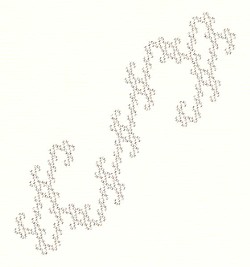 |
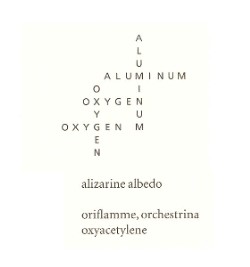 |
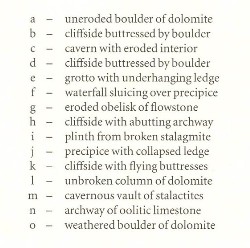 |
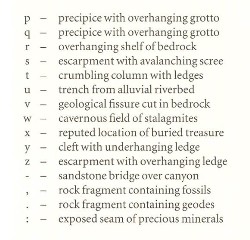 |
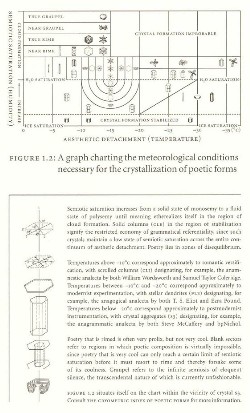 |
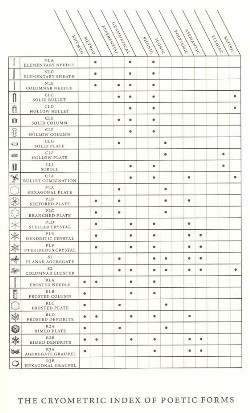 |
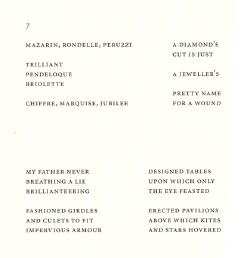 |
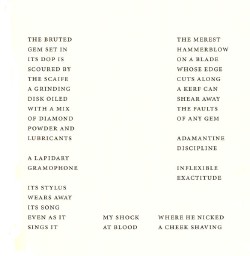 |
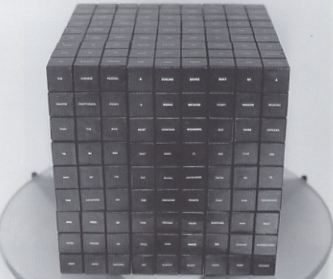 |
| Figure
8: Bibliomechanics Christian Bök Twenty-seven Rubik's Cubes with printed lettering. 6-3/4" x 6-3/4" x 6-3/4" Courtesy of the artist. |
English Department
York University
svoyce@yorku.ca
Talk Back
COPYRIGHT © 2007 Stephen Voyce. READERS MAY USE
PORTIONS OF THIS WORK IN ACCORDANCE WITH THE FAIR USE PROVISIONS OF U.S.
COPYRIGHT LAW. IN ADDITION, SUBSCRIBERS AND MEMBERS OF SUBSCRIBED
INSTITUTIONS MAY
USE THE ENTIRE WORK FOR ANY INTERNAL NONCOMMERCIAL PURPOSE BUT, OTHER THAN
ONE COPY SENT BY EMAIL, PRINT OR FAX TO ONE PERSON AT ANOTHER LOCATION FOR
THAT INDIVIDUAL'S PERSONAL USE, DISTRIBUTION OF THIS ARTICLE OUTSIDE OF A
SUBSCRIBED INSTITUTION WITHOUT EXPRESS WRITTEN PERMISSION FROM EITHER THE
AUTHOR OR THE JOHNS HOPKINS UNIVERSITY PRESS IS EXPRESSLY FORBIDDEN.
THIS ARTICLE AND OTHER CONTENTS OF THIS ISSUE ARE
AVAILABLE FREE OF CHARGE UNTIL RELEASE OF THE NEXT ISSUE. A
TEXT-ONLY ARCHIVE OF THE JOURNAL IS ALSO AVAILABLE FREE OF CHARGE.
FOR FULL HYPERTEXT ACCESS TO BACK ISSUES, SEARCH UTILITIES, AND OTHER
VALUABLE FEATURES, YOU OR YOUR INSTITUTION MAY SUBSCRIBE TO
PROJECT MUSE, THE
ON-LINE JOURNALS PROJECT OF THE
JOHNS HOPKINS UNIVERSITY PRESS.
Notes
1. The Flash realization of Eunoia's "Chapter E" was created by Brian Kim Stefans. Eunoia was recorded on 2 June 2002, by Steve Venright in Toronto, Canada.
2. Marjorie Perloff, in her latest book, provides an astute reading of Eunoia in these terms. She observes that each chapter exposes the "semantic overtones" of each vowel, so that, indeed, the vowels seem to speak on their own behalf. See Perloff 205-26.
3. Silliman's review of Eunoia appeared on his blog (<http://ronsilliman.blogspot.com/>), dated 9 April 2002.
4. The full text of Bök's essay can be found online at <http://www.ubu.com/papers/object.html>.
5. Note that "Mushroom Clouds" comes directly after "Motorized Razors" on the same mp3 file.
6. On the morning of 11 May 2004, the artist Steve Kurtz called 911 to report the death of his wife, who had succumbed to heart failure. Upon entering the home, local law enforcement encountered biological materials and lab equipment, which Kurtz and other members of the Critical Arts Ensemble routinely use in their art installations. Local authorities promptly called the FBI, and Kurtz was briefly detained under terrorism legislation. Although a grand jury later rejected charges of terrorism, the associate professor at SUNY Buffalo was still charged with federal criminal mail and wire fraud, and faces a possible twenty year sentence if convicted.
Works Cited
Barthes, Roland. Mythologies. Trans. Annette Lavers. New York: Hill and Wang, 1972.
Perloff, Marjorie. Differentials: Poetry, Poetics, Pedagogy. Tuscaloosa, AL: U of Alabama P, 2004.
